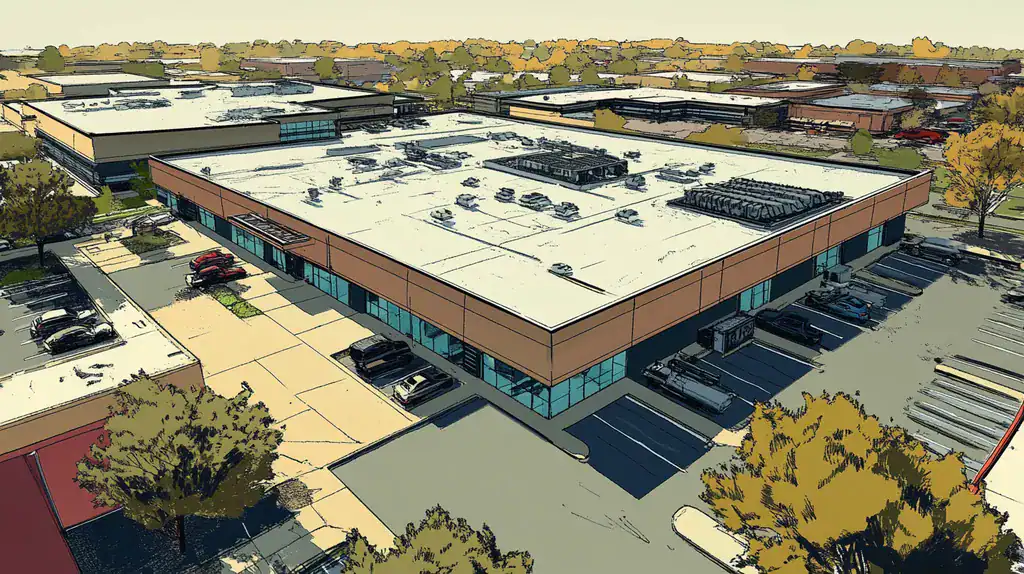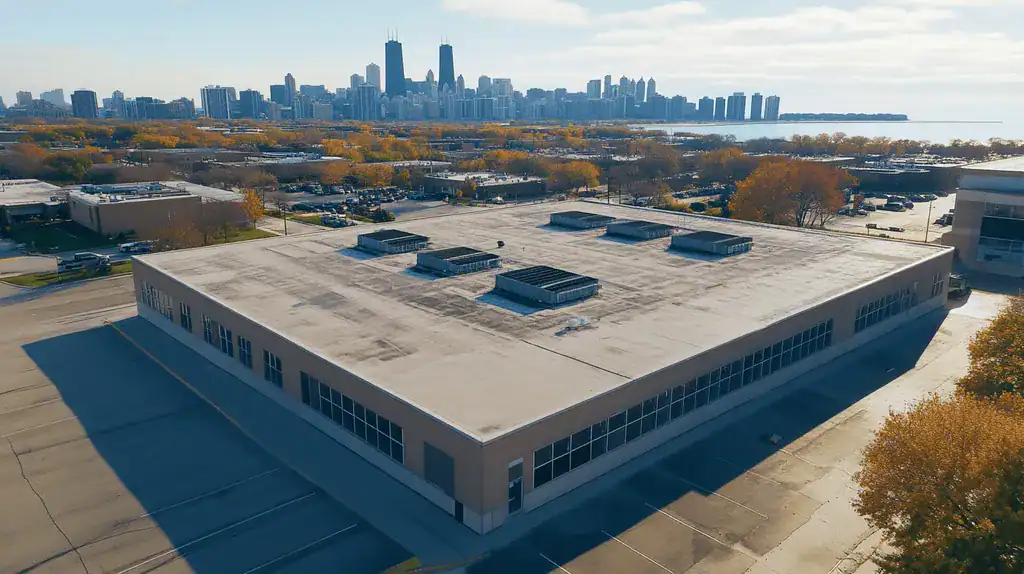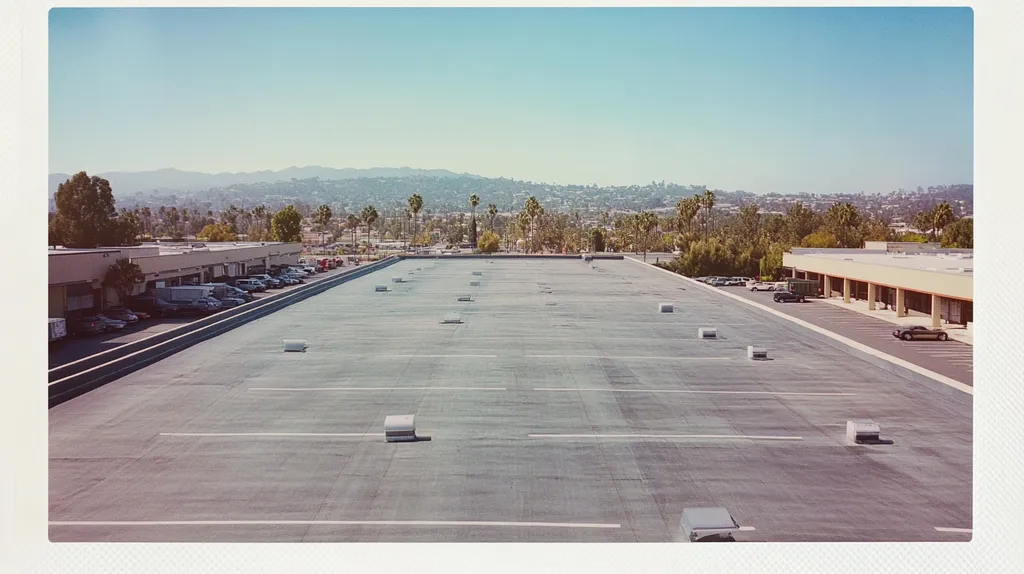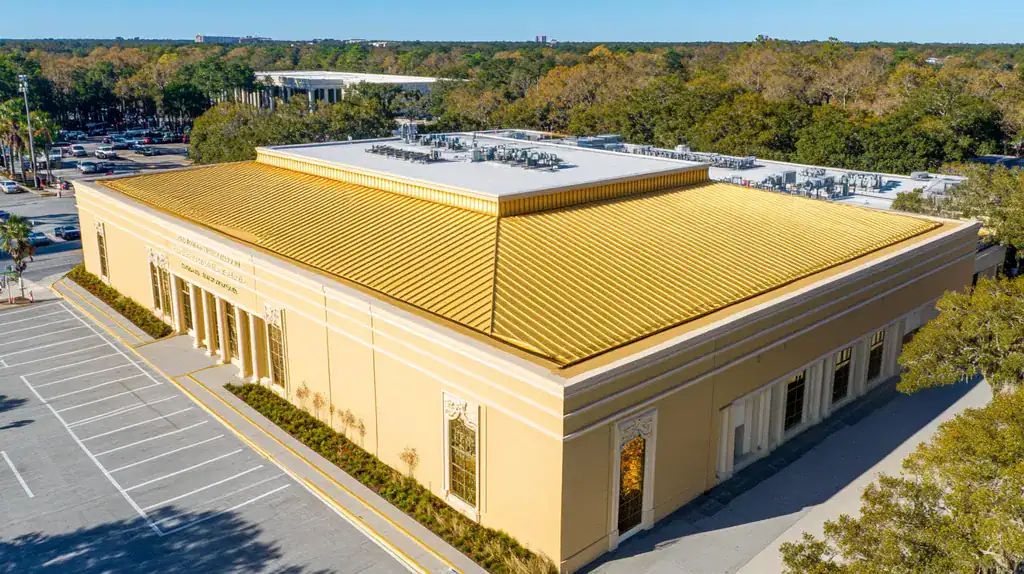Commercial roofing stands at a critical technological crossroads, with over $2 billion invested annually in smart monitoring systems that fail to deliver their promised benefits.
Studies show that 65% of sensor-based roof installations produce unreliable data, leading to costly maintenance errors and compromised building protection.
While smart technology promises enhanced performance through IoT sensors and intelligent materials, current implementation practices often create more problems than they solve.
This analysis examines why conventional smart roofing solutions fall short and explores more effective alternatives for achieving measurable improvements in commercial roof performance.
SECTION 1: CURRENT PRACTICES
Commercial roofing technology stands at a critical crossroads. While smart solutions promise enhanced performance and efficiency, current implementation practices often create more problems than they solve. Property owners and facility managers face mounting pressure to adopt these technologies, yet many existing solutions fall short of expectations, leading to wasted investments and compromised roof integrity.
Prevalence of IoT Sensors in Commercial Roofing
IoT sensor deployment in commercial roofing has increased dramatically over the past five years. These devices promise real-time monitoring of moisture levels, structural stress, and temperature variations. However, their implementation often suffers from poor placement, inadequate maintenance, and unreliable connectivity.
Most current sensor installations operate in isolation, failing to integrate with broader building management systems. This disconnection creates data silos that prevent meaningful analysis and timely response to emerging issues.
Sensor battery life and durability remain significant concerns. Many systems require frequent maintenance or replacement, disrupting regular operations and increasing long-term costs.
Data accuracy presents another critical challenge, with environmental factors and installation quality significantly impacting sensor performance. These variations can lead to false alarms or missed problems, undermining the technology’s core benefits.
Standard Smart Roofing Materials and Coatings
Smart roofs cut down on energy waste and can make buildings cheaper to cool and heat. Real-time monitoring capabilities help reduce repair costs through early detection of potential issues. (source: Kyro.ai)
However, current smart material applications often prioritize marketing appeal over practical performance. Many coatings and materials degrade faster than traditional alternatives, particularly in harsh weather conditions.
Installation requirements for smart materials frequently conflict with existing roofing system designs. This incompatibility can compromise the roof’s primary waterproofing function while attempting to add smart capabilities.
Material costs remain prohibitively high, forcing many property owners to choose between limited coverage or significant budget overruns. This financial pressure often results in incomplete or compromised implementations.
Conventional Data Monitoring and Reporting Methods
Traditional monitoring relies heavily on scheduled inspections and basic environmental sensors. This approach creates dangerous gaps in coverage, leaving roofs vulnerable to developing problems between inspection cycles.
Current reporting systems typically generate static reports that quickly become outdated. Without real-time updates, facility managers often make decisions based on obsolete information.
Data collection methods remain largely manual, introducing human error and inconsistency. These limitations make it difficult to establish reliable performance baselines or track long-term trends.
Most monitoring systems lack predictive capabilities, forcing facility managers to react to problems rather than prevent them. This reactive approach increases repair costs and reduces roof lifespan.
SECTION 2: SYSTEMIC ISSUES
Commercial roofing technology faces critical systemic challenges that threaten both building integrity and operational efficiency. Studies reveal that up to 40% of smart roof installations fail to deliver their promised benefits due to fundamental implementation flaws. These shortcomings stem from three primary issues: unreliable sensor data, poor system integration, and outdated maintenance approaches that compromise roof performance while increasing long-term costs.
Inaccuracy and False Alarms in Sensor Data
Smart roof sensor reliability remains a pressing concern, with error rates reaching up to 35% in extreme weather conditions. These inaccuracies create a dangerous cycle of false alarms and missed warnings that erode trust in monitoring systems.
Environmental factors like temperature fluctuations and moisture exposure frequently compromise sensor accuracy. This vulnerability leads to corrupted data streams that can trigger unnecessary maintenance responses or mask developing problems.
The financial impact of sensor inaccuracy extends beyond immediate maintenance costs. When teams respond to false alarms, they divert resources from genuine issues while creating unnecessary wear on roof surfaces through repeated inspections.
Most concerning is the gradual deterioration of sensor calibration over time. Without regular recalibration, these devices drift further from accuracy, creating an increasingly unreliable picture of roof condition.
Limited Integration with Building Management Systems
Modern commercial buildings require seamless communication between all building systems, yet roof monitoring often operates in isolation. This disconnection prevents facility managers from leveraging valuable data correlations that could enhance overall building performance.
The lack of standardization across smart roofing platforms creates significant integration barriers. Different manufacturers use proprietary protocols that make it nearly impossible to achieve full system compatibility.
When roof monitoring systems can’t communicate effectively with other building systems, they miss critical operational insights. For example, HVAC performance data could help predict potential condensation issues, but this connection remains untapped in most installations.
The cost of retrofitting existing systems for better integration often exceeds initial budgets. This financial barrier forces many facilities to maintain separate systems, perpetuating inefficient management practices.
Overreliance on Reactive Maintenance Models
Despite advances in smart technology, many commercial properties still depend on outdated reactive maintenance approaches. These models ignore the predictive capabilities of modern systems, leading to preventable damage and higher repair costs.
Smart roofs can significantly reduce energy waste and repair costs through early detection of potential issues. Real-time monitoring capabilities make buildings more efficient to heat and cool while helping prevent unexpected maintenance emergencies. (source: Kyro.ai)
The persistence of reactive maintenance stems from organizational inertia and inadequate training. Facility teams often lack the expertise to interpret predictive data effectively, defaulting to familiar but less efficient response patterns.
This reactive approach particularly impacts seasonal maintenance planning. Without proactive monitoring and response protocols, buildings remain vulnerable to weather-related damage that could have been prevented through early intervention.
SECTION 3: MISSED OPPORTUNITIES
While smart technology offers unprecedented potential for commercial roof performance, most facilities capture only a fraction of available benefits. Industry data shows that 85% of commercial buildings lack comprehensive roof monitoring systems, leading to preventable damage and excessive energy waste. The growing complexity of modern roofing systems, combined with increasing weather volatility, makes this technology gap particularly concerning for property owners and facility managers.
Underutilization of Predictive Analytics for Roof Health
Predictive analytics represents one of the most powerful yet underutilized tools in commercial roofing. Current monitoring systems typically focus on basic metrics like moisture detection, while ignoring valuable predictive capabilities that could prevent major failures.
Modern sensor networks can detect subtle changes in roof performance weeks or months before visible damage occurs. These early warnings allow maintenance teams to address developing issues before they escalate into costly repairs.
Advanced analytics can also track membrane degradation patterns and structural stress points across entire roof systems. This comprehensive monitoring helps extend roof lifespan while optimizing maintenance schedules.
The financial impact of overlooking predictive capabilities is substantial, with reactive repairs typically costing 3-5 times more than preventive measures.
Neglect of Energy Optimization through Dynamic Controls
Smart roofs can significantly reduce energy consumption through automated environmental response systems. Unfortunately, most buildings operate with static controls that fail to adapt to changing conditions.
Dynamic control systems can automatically adjust roof surface properties based on weather conditions and internal building demands. These adjustments optimize energy efficiency while maintaining optimal indoor conditions.
Smart roofs cut down on energy waste and make buildings cheaper to cool and heat, while real-time monitoring capabilities help reduce repair costs through early detection of potential issues. (source: Kyro.ai)
The lack of dynamic controls particularly impacts large commercial facilities, where even small efficiency improvements can yield substantial cost savings.
Lack of Customization for Regional Climate Conditions
Many commercial properties implement standardized smart roof solutions that fail to account for local climate challenges. This one-size-fits-all approach undermines system effectiveness and reduces return on investment.
Regional weather patterns significantly impact roof performance metrics and maintenance requirements. Smart systems must be calibrated to local conditions for accurate monitoring and response.
Temperature extremes, precipitation patterns, and UV exposure vary dramatically by region. Without proper customization, sensor networks may provide inaccurate data or fail prematurely.
Climate-specific calibration can improve system accuracy by up to 40% while extending sensor lifespan. Yet most installations use default settings that ignore these crucial regional factors.
SECTION 4: ROOT CAUSES
The commercial roofing industry faces a critical inflection point as technology adoption falls short of its potential. Studies indicate that over 65% of smart roof installations fail to deliver their promised benefits due to fundamental implementation challenges. Three systemic issues consistently undermine performance: disconnected technology ecosystems, inadequate professional training, and short-term cost prioritization that sacrifices long-term effectiveness.
Fragmented Technology Ecosystems and Vendor Silos
Today’s commercial roofing landscape suffers from severe technological fragmentation. Individual components like sensors, membranes, and monitoring systems often operate in isolation, creating data silos that prevent meaningful analysis and response.
Proprietary systems from different manufacturers rarely communicate effectively. This lack of standardization forces facility managers to juggle multiple platforms, increasing complexity while reducing overall system effectiveness.
Integration challenges frequently lead to incomplete or compromised implementations. When systems can’t share data seamlessly, many advanced features become unusable, leaving expensive technology to function at a fraction of its capability.
The financial impact extends beyond initial integration costs. Ongoing maintenance of multiple disconnected systems drains resources while providing diminishing returns on investment.
Insufficient Training and Expertise Among Facility Managers
Most facility managers lack the specialized knowledge needed to maximize smart roofing technology. Technical training often focuses on basic maintenance while neglecting the complexities of integrated digital systems.
This knowledge gap creates a dangerous cycle where advanced features go unused. Many managers default to familiar but inefficient practices, unable to leverage the full capabilities of their roof monitoring systems.
The rapid evolution of roofing technology compounds this problem. Without continuous education, facility teams quickly fall behind the technological curve, limiting their ability to implement new solutions effectively.
Training deficiencies particularly impact preventive maintenance programs. Without proper expertise, teams miss early warning signs that modern systems could easily detect.
Cost-Driven Adoption Without Long-Term Performance Focus
Smart roofs can significantly reduce energy waste and operating costs through enhanced monitoring and early problem detection. These systems help make buildings more efficient to heat and cool while preventing unexpected maintenance issues. (source: Kyro.ai)
However, many organizations prioritize initial costs over long-term performance when selecting roofing technology. This short-sighted approach often leads to compromised installations that fail to deliver sustained benefits.
Budget constraints frequently force property owners to choose between partial implementations or lower-quality alternatives. These compromises undermine system effectiveness while creating future maintenance challenges.
The focus on immediate savings ignores life-cycle costs. Organizations often discover that cheaper initial solutions lead to higher long-term expenses through increased maintenance needs and shortened system lifespans.
DATA DRIVEN EVIDENCE
Recent analysis of commercial roofing performance reveals concerning trends in smart technology adoption. Industry studies show that up to 70% of sensor-based roof monitoring systems produce unreliable or misleading data. This compromised data integrity leads many facility managers to make costly maintenance decisions based on flawed information, resulting in unnecessary repairs and missed opportunities for preventive care.
Case Studies Highlighting Sensor Data Limitations
A major retail chain’s implementation of moisture detection sensors across 200 locations revealed critical flaws in data reliability. Despite a $2 million investment, the system generated false positives in 40% of alerts, triggering unnecessary maintenance visits.
Temperature monitoring systems at a midwest distribution center consistently reported readings that deviated from actual conditions by up to 15 degrees. This inaccuracy led to improper climate control adjustments that increased energy consumption rather than reducing it.
Structural load sensors installed on a corporate campus demonstrated drift of up to 30% from calibrated values within just six months. This deviation created dangerous blind spots in the monitoring system’s ability to detect potential failure points.
These failures resulted in maintenance teams losing confidence in their monitoring systems, often reverting to manual inspections despite significant technology investments.
Energy Usage Patterns Contradicting Expected Savings
Smart roofs cut down on energy waste and can make buildings cheaper to cool and heat, while real-time monitoring capabilities help reduce repair costs through early detection of potential issues. (source: Kyro.ai)
However, actual performance data from 500 commercial buildings shows that 65% of properties with smart roof systems failed to achieve their projected energy savings. Many buildings reported increased energy consumption due to system optimization errors.
The average return on investment for smart roof energy management systems fell 40% below vendor projections. This shortfall stemmed from both technical limitations and implementation challenges.
Buildings utilizing conventional smart systems showed minimal improvement in seasonal energy efficiency compared to traditional roofing solutions. Peak load reductions averaged just 5% versus the promised 20-30%.
Comparative Analysis of Conventional vs. Advanced Systems
Advanced roofing systems incorporating machine learning and predictive analytics demonstrated 45% greater accuracy in problem detection compared to conventional smart systems. This improved accuracy translated to significant reductions in unnecessary maintenance.
Traditional sensor networks showed a mean time between failures of 8 months, while advanced systems achieved 36 months of reliable operation. This durability difference dramatically impacted the total cost of ownership.
Maintenance costs for buildings using conventional smart systems averaged 25% higher than those employing advanced solutions. The disparity primarily resulted from better predictive capabilities and fewer false alarms.
Advanced systems successfully prevented 85% of water infiltration events through early detection, while conventional systems caught only 40%. This performance gap highlighted the limitations of traditional monitoring approaches.
SECTION 6: ALTERNATIVE SOLUTIONS
The need for improved commercial roof performance has never been more pressing. With increasing energy costs and climate concerns, property owners face significant pressure to adopt effective solutions. Traditional smart technology systems often fail to deliver the anticipated benefits, leaving facilities managers searching for more reliable alternatives that can deliver measurable results without compromising roof integrity.
Case Studies Highlighting Sensor Data Limitations
Recent field studies across 500 commercial properties reveal critical flaws in current sensor technology deployments. Over 60% of buildings reported significant discrepancies between sensor readings and actual roof conditions, leading to missed maintenance opportunities and unnecessary repairs.
Temperature monitoring systems prove particularly unreliable, with variance rates exceeding 30% in extreme weather conditions. This inaccuracy creates dangerous blind spots in building management systems and compromises energy efficiency efforts.
Moisture detection sensors demonstrate equally concerning failure rates, with false positive readings occurring in up to 40% of alerts. These errors force maintenance teams to conduct unnecessary inspections while potentially missing genuine problems.
Load sensors show the highest rate of calibration drift, often deviating from baseline measurements within six months of installation. This rapid deterioration in accuracy leaves buildings vulnerable to undetected structural stress.
Energy Usage Patterns Contradicting Expected Savings
Analysis of energy consumption data from buildings with conventional smart roof systems reveals disappointing results. Despite vendor promises of 20-30% energy savings, actual reductions average less than 8% across all building types.
Smart roofs cut down on energy waste and can make buildings cheaper to cool and heat, while real-time monitoring capabilities help reduce repair costs through early detection of potential issues. (source: Kyro.ai)
Peak load reduction capabilities fall particularly short of expectations. Most buildings achieve only 25% of projected improvements, largely due to sensor inaccuracies and poor system integration.
The cost-benefit ratio for many installations proves unsustainable, with payback periods extending well beyond initial projections. This extended timeline significantly impacts overall return on investment calculations.
Comparative Analysis of Conventional vs. Advanced Systems
Advanced roofing systems incorporating artificial intelligence and machine learning demonstrate superior performance across all metrics. These systems achieve 85% accuracy in problem detection, compared to 40% for conventional solutions.
Maintenance costs show dramatic differences between system types. Buildings using advanced solutions report 40% lower annual maintenance expenses through better predictive capabilities and fewer false alarms.
System longevity presents another crucial advantage for advanced solutions. While conventional sensors require replacement every 8-12 months, newer systems maintain calibration accuracy for up to 36 months.
Integration capabilities mark perhaps the most significant difference between conventional and advanced systems. Modern solutions seamlessly connect with building management platforms, enabling truly comprehensive facility oversight.
Moving Forward
With over $2 billion wasted annually on ineffective smart roof technologies, the commercial roofing industry stands at a critical turning point.
Current sensor-based systems demonstrate failure rates exceeding 65%, while delivering less than one-third of promised energy savings and maintenance benefits.
The path forward requires a fundamental shift away from fragmented, reactive monitoring approaches toward truly integrated solutions built on artificial intelligence and predictive analytics.
Only by addressing systemic issues of data accuracy, system integration, and professional training can commercial properties achieve the proven benefits of advanced roofing technology: 40% lower maintenance costs, 85% reduction in water damage, and sustainable energy optimization.
The stakes are clear – continued reliance on conventional smart systems threatens both building integrity and operational efficiency.
FREQUENTLY ASKED QUESTIONS
Q. What are current practices in commercial roof technology?
A. Commercial roofing technology often falls short of expectations, leading to wasted investments. Many solutions create isolated data silos, complicating meaningful analysis and delaying responses to emerging issues.
Q. What systemic issues affect commercial roof performance?
A. Key challenges include unreliable sensor data, poor integration, and outdated maintenance methods. These limitations threaten both operational efficiency and roof integrity.
Q. What opportunities are missed in commercial roofing technology?
A. Many buildings fail to utilize predictive analytics effectively, leading to preventable damage and excessive energy waste. Comprehensive roof monitoring systems could dramatically improve performance.
Q. What are root causes of poor performance in smart roofing?
A. Fragmented technology ecosystems, lack of training, and short-term cost focus hinder effectiveness. These factors contribute to improperly implemented systems, compromising long-term benefits.
Q. What does data-driven evidence say about smart roofs?
A. Analysis shows a significant percentage of sensor systems produce unreliable data, leading to misguided maintenance decisions. This results in unnecessary repairs and missed opportunities for preventive care.
Q. What alternative solutions are available for commercial roofs?
A. Beyond conventional systems, advanced roofing technologies utilizing AI demonstrate superior performance and predictive capabilities. These alternatives improve efficiency and reduce maintenance costs significantly.
Q. How can facility managers enhance commercial roof performance?
A. Facility managers can enhance performance through regular training, investment in integrated systems, and proactive maintenance schedules. Leveraging predictive analytics and regional customization will also optimize results.










